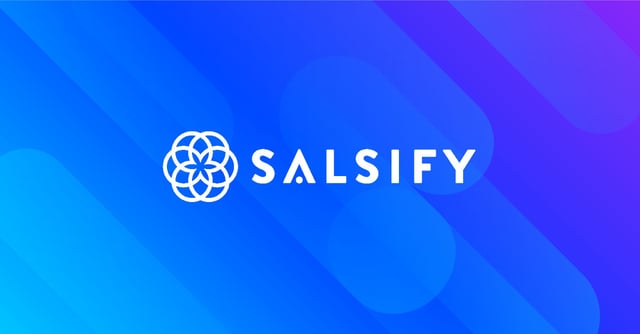

Salsify GDSN Data Pool
Learn how the Salsify GDSN Data Pool can help you centralize and connect with your trading partners — all within a unified PXM platform.
LEARN MOREPIM
Manage all product content in one central system of record.
Syndication
Easily syndicate product content to every consumer touch point.
Enhanced Content
Enrich product pages with below-the-fold content and rich media.
Intelligence Suite
Bring AI-powered capabilities directly into your Salsify workflows.
Grocery Accelerator
Leverage the first-ever category-wide PXM accelerator in the grocery industry.
GDSN Data Pool
Synchronize standard supply chain, marketing, and ecommerce attributes globally.
Digital Shelf Analytics
Continuously optimize your organization’s product content syndication.
Catalog Sites
Share secure, on-brand, and always up-to-date digital product catalogs.
Automation and AI
Automate business processes and enhance Salsify workflows with AI.
PXM Platform, Integrations, and APIs
Integrate the PXM platform with the rest of your enterprise systems architecture.
Supplier Onboarding
Accelerate supplier onboarding while ensuring your schema requirements are met.
Product Listing
Sell products faster with Product Listing.
Content Enrichment
Increase online conversions with Content Enrichment.
Automation
Save time and increase operational efficiency with retail automation.
SXM Platform, Integrations, and APIs
Integrate the SXM platform with the rest of your enterprise systems architecture.
Syndication Network
Automate how you exchange product content data to the digital shelf.
Enhanced Content Network
Turn product pages into product experiences with Enhanced Content.
Commerce Platform Integrations
Create winning product experiences everywhere shoppers are, including on owned sites.
GDSN Data Pool
Synchronize standard supply chain, marketing, and ecommerce attributes globally.
Open Catalog
Connect to the digital shelf faster with an open, standardized, and free product catalog.
Resources
Resource Library
Explore our ecommerce resources to get everything you need to win on the digital shelf.
Blog
Read our blog to get actionable insights for navigating changing markets and industry demands.
Webinars
Watch our on-demand ecommerce webinars to gain expert advice and tips from our community of industry leaders.
Customer Blog
Gain the latest tips, industry trends, and actionable ecommerce insights.
Knowledge Base
Investigate our knowledge base to build your Salsify skills and understanding.
API
Examine our comprehensive API and webhook guides to start working with Salsify quickly.

Download the report to get expert insights, consumer research, and top industry trends.

Who should manage Global Data Synchronization Network (GDSN) projects within your organization?
Given the logistics-centric origins of the GDSN, it’s not surprising that IT or supply chain teams — not ecommerce teams — own most of this responsibility.
However, the GDSN is not limited to logistics data: It transmits image URLs and marketing feature bullets as efficiently as it can share weights and packaging hierarchy.
While it may be long before a critical mass of retailers accept all of the rich content required for omnichannel item setup with the GDSN, retailers can currently leverage some of the submitted attributes.
Since these GS1 Global Data Dictionary (GDD) attributes may ultimately flow through to customer-facing applications, such as website product pages, ecommerce teams must understand how the data flows and implement a proactive strategy to take full advantage of the opportunity.
The most agile brands break down this problem by divvying up organizational responsibility. Here are some tips for breaking it up successfully at your organization.
This responsibility should continue to live with the supply chain team and be mastered within your existing enterprise resource planning (ERP) and warehouse management systems.
The digital content hubs used by sales, marketing, and ecommerce teams must be flexible enough to seamlessly pull this information in without sacrificing any of the existing investments in data governance already made by IT.
This responsibility includes a wide variety of content, including romance copy, feature bullets, digital imagery, videos, and product specifications used to drive faceted browsing and comparison on retailer websites.
Some of this content can and should be mapped to GDD attributes and transmitted via GDSN.
At a minimum, you need to ensure your digital content hub is extensible enough to easily drive the collection and maintenance of this content via integrations, workflows, and end-user editing. It must also cleanly map these attributes where possible to the GDSN.
This step can be a potential minefield because what each retailer can leverage is evolving rapidly (and often in a poorly documented fashion). Working with a partner with experience with some of the esoteric details can help make this process easier.
This responsibility must be a joint activity across ecommerce, sales, and logistics teams. There is often a lack of consistency in where ultimate ownership and sign-off live: In most organizations, it tends to be owned by logistics teams. However, there has been an increase in ecommerce team ownership — or those responsible for item setup sheets and other ecommerce retailer setups.
The best practice for this responsibility is leveraging a machine-to-machine solution for GDSN publication and not relying on spreadsheet downloads and uploads. Your digital content hub should have native GDSN publication capabilities built-in to support this requirement, as well as any other content reuse initiatives.

Learn how the Salsify GDSN Data Pool can help you centralize and connect with your trading partners — all within a unified PXM platform.
LEARN MORESalsify helps thousands of brand manufacturers, distributors, and retailers in over 140 countries collaborate to win on the digital shelf.
Standing out on the digital shelf starts with access to the latest industry content. Subscribe to Below the Fold, our monthly content newsletter, and join other commerce leaders.